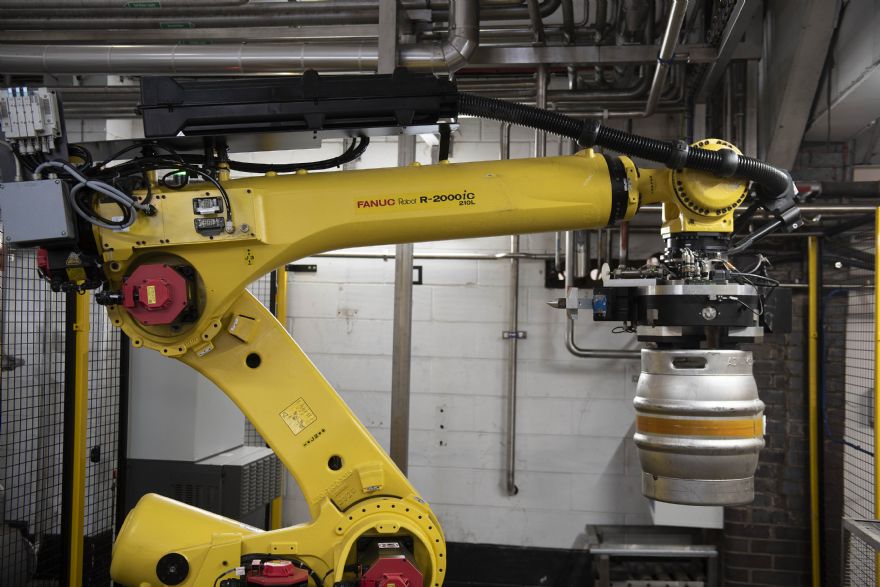
While brewing in Britain pre-dates the Roman invasion in 43AD, its evolution has helped to make the food and beverage industry the UK’s largest manufacturing sector. Numerous breweries have established themselves as household names, including Adnams (
www.adnams.co.uk), which still operates out of its original 18th-century site in Suffolk. However, the company’s commitment to tradition has not stopped it implementing 21st-century automation solutions.
Head brewer Fergus Fitzgerald said: “Adnams Brewery has been in Southwold since 1872. We brew mostly cask beers but have expanded our range over the last few years to include a variety of keg beers — and set up a distillery.
“We can brew up to 40 different beers over the course of a year; we have our core beers that we do ‘day in, day out’, but we also have our seasonal beers — and one-offs. We brew about 100,000 barrels a year, although by ‘barrel’ I mean a brewer’s barrel, which is 163 litres.”
Operating a 21st-century brewery in a 19th-century building (on an even older site) has proved to be a considerable challenge, as Adnams has looked to keep pace with modern brewing methods and consumer demand for a wider portfolio of beers and spirits.
One area where the brewery has looked to make progress is the introduction of automation — including the use of robotic end-of-line palletising systems to manipulate the beer barrels, once they have been filled.

Mr Fitzgerald said: “While we have expanded our portfolio in recent years, cask beer remains a core part of the brewery.
At the end of our main cask filling line, where we put the beer into the barrels, we had an old palletiser that took up a lot of space. We identified a new piece of technology that would allow us to brew a 0.5%-alcohol version of our Ghost Ship Pale Ale, but we had no available floor space.
However, by replacing the old palletiser with a more compact automated solution, we figured that we could accommodate everything we needed within the existing brewery site. In early 2018 we approached Fanuc to design a robotic end-of-line loading system.”
‘Fast operator’For the task of handling metal barrels filled with over 160 litres of beer, Coventry-based Fanuc (
www.fanuc.eu/uk/en) specified its R-200iC/210L six-axis palletising robot.
With a maximum payload of 210kg, this could comfortably process the full casks at the required rate of 250-300 barrels per hr, to keep pace with the beer as it came out of the filling line. With a compact footprint of 771 x 610mm and a reach of 3,100mm, it can easily operate within the confined working environment of the brewery.
Crucially, the robot body is IP54-rated to protect it from the residual beer in the cask-filling line. However, the R-200iC/210L was not Adnams’ first foray into robotics.
Back in 2017, in response to the growing popularity of keg beers, the company decided to expand its keg programme and bring the kegging process in-house.
This involved finding space for conditioning tanks, as well as filtration and kegging equipment. The final piece of the puzzle was the installation of a Fanuc R-2000iC/165F robot, which was used to lift and stack the newly filled kegs.
Robot loading is twice as fastWhile this was on a much smaller scale than the brewery’s cask line, its success paved the way for the much larger system that followed. All of the brewery’s cask and keg beers are now handled and loaded by robots.
Mr Fitzgerald said: “Compared to a manual process, automation is much better. Robot loading is twice as fast as manual loading, and it takes all the health-and-safety issues linked to manual handling out of the equation.”
However, there was another factor that helped to tip the balance in favour of a robot loading system, rather than a like-for-like palletiser.
Mr Fitzgerald said: “One of the main reasons we chose the robot system was that we wanted to move away from wooden pallets, which we had been using for years, and to start using plastic ‘locator’ boards.
“These are durable items that allow barrels to be stacked securely and safely on top one another. Moreover, they are light, cost less, last longer — and allow more product to be loaded on a vehicle.”
At Adnams’ cask-palletising system, the Fanuc R-200iC/210L will pick six filled casks off the line and place them on a conveyor, in two rows of three.
The robot will then select a locator board from a magazine stored within the cell and place it on top of the six barrels, before collecting the next six barrels from the filling line and stacking them on top.
When there are 18 barrels securely stacked, they are moved to the end of the conveyor, where they can be collected by fork-lift truck and either loaded onto a lorry or stored nearby until ready for collection.